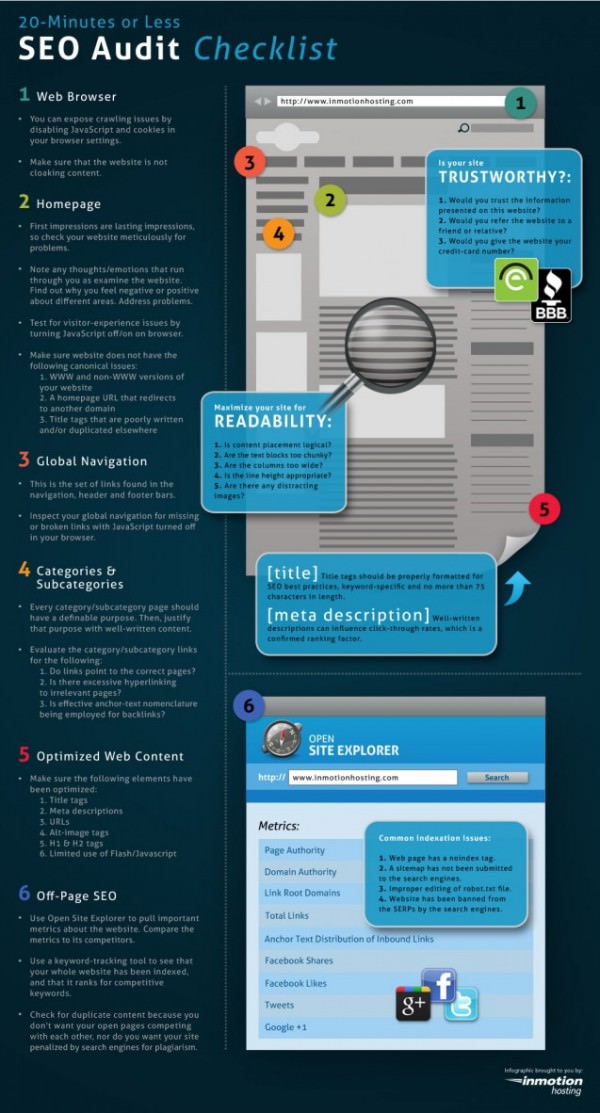Uncover hidden website secrets with an in-depth analysis of SEO audit. Boost your online visibility and ranking today!

Image courtesy of via DALL-E 3
Table of Contents
Introduction to SEO Audit
When you have a website, you want people to find it easily and quickly when they search for something online. That’s where SEO comes in. SEO stands for Search Engine Optimization, and it helps your website show up higher in search engine results. But how do you know if your website is optimized for SEO? This is where an SEO audit becomes essential.
What is SEO?
SEO is like a secret code that helps search engines understand what your website is all about. By using the right keywords and optimizing your content, you can improve your website’s visibility and attract more visitors. It’s like planting seeds in a garden to grow beautiful flowers!
What is an SEO Audit?
Think of an SEO audit as a health check-up for your website. Just like you visit the doctor to make sure you’re healthy, an SEO audit checks if your website is performing at its best. It looks for issues that might be holding your site back from reaching its full potential.
Importance of an SEO Audit
One of the key reasons why conducting an SEO audit is crucial for a website is to identify and address issues that may be hindering its performance. Just like how a regular check-up helps keep our bodies healthy, an SEO audit helps ensure that your website is running smoothly and efficiently.
Attracting More Visitors
By fixing SEO issues uncovered during an audit, you can make your website more visible to potential visitors. Think of it as making your website easier to find in a crowded marketplace. The better optimized your site is, the more likely it is that people looking for your products or services will discover it.
Components of an SEO Audit
An essential part of an SEO audit is the technical audit, which involves evaluating the technical aspects of a website to ensure optimal performance. This includes checking the site’s structure, speed, and mobile-friendliness. A technical audit helps in identifying any issues that might be hindering the website’s visibility on search engines.

Image courtesy of via Google Images
Content Audit
Another crucial component of an SEO audit is the content audit. This part focuses on assessing the quality and relevance of the website’s content. A content audit helps in determining whether the content meets the needs of the target audience and aligns with the website’s goals. By analyzing the content, SEO experts can make recommendations for improvement to enhance visibility and engagement.
Tools Used in an SEO Audit
When professionals conduct an SEO audit to evaluate the health and performance of a website, they rely on various tools to gather data and identify issues effectively. These tools play a crucial role in providing insights and recommendations for improving a site’s search engine optimization. Let’s explore some common tools used in an SEO audit:
Google Analytics
Google Analytics is a powerful tool that allows website owners to track and analyze their website’s performance. By providing valuable data on visitor behavior, traffic sources, and conversions, Google Analytics helps in understanding how users interact with the site. This information is essential for making informed decisions and optimizing the website for better search visibility.
Screaming Frog
Screaming Frog is another popular tool used in SEO audits to analyze a website’s technical aspects. It crawls through the site, identifying issues such as broken links, duplicate content, and missing meta tags. By generating detailed reports, Screaming Frog helps in pinpointing areas that need attention and improvement. This tool is indispensable for ensuring that the website’s technical foundation is strong and optimized for search engines.
By leveraging these tools and others like SEMrush, Moz, and Ahrefs, SEO professionals can conduct thorough audits, identify opportunities for enhancement, and implement strategies to boost a website’s search engine performance.
Steps to Perform an SEO Audit
Performing an SEO audit for your website is crucial to ensure it ranks well on search engines and attracts more visitors. Here are some simple steps to help you conduct an effective SEO audit:

Image courtesy of via Google Images
Crawl Your Site
The first step in performing an SEO audit is to crawl your website. This involves using tools that scan and analyze your site’s structure, identifying any issues that need to be addressed. Crawling your site helps you understand how search engines view your website and pinpoint areas for improvement.
Check Site Speed
Site speed is a critical factor in SEO rankings. Slow-loading websites can drive visitors away and lower your search engine rankings. Use tools to test your site’s speed and identify ways to optimize it. Common methods for improving site speed include optimizing images, minifying CSS and JavaScript files, and leveraging browser caching.
Common Issues Detected in an SEO Audit
Broken links are like dead ends on a website. When a visitor clicks on a broken link, they are taken to a page that no longer exists. This can frustrate users and harm the website’s ranking on search engines. In an SEO audit, broken links are identified so they can be fixed promptly to ensure a smooth user experience.
Duplicate Content
Imagine telling the same story over and over again without adding anything new. That’s what duplicate content is like on a website. Search engines get confused when they find the same content in multiple places, which can lower the site’s ranking. An SEO audit helps identify duplicate content so that it can be revised or removed to improve the website’s performance.
How to Fix SEO Issues Found in an Audit
After conducting an SEO audit, you may discover various issues that need to be addressed to improve your website’s performance. Here are some common problems that can be fixed with simple solutions:

Image courtesy of via Google Images
Fixing Broken Links
Broken links are hyperlinks on a website that no longer work, leading visitors to pages that do not exist. These broken links can harm your site’s user experience and SEO rankings. To fix broken links, you can use online tools to scan your website and identify any broken links. Once identified, you can either update the links to direct to the correct pages or remove them entirely. Regularly checking for broken links and fixing them promptly will help improve your site’s usability and overall SEO performance.
Improving Content Quality
High-quality, relevant content is essential for attracting visitors and improving your website’s search engine rankings. To enhance the quality of your content, consider the following tips:
- Update outdated content with fresh information and insights.
- Include relevant keywords naturally within your content to boost its visibility in search results.
- Create engaging, informative content that provides value to your audience.
By consistently improving the quality of your content, you can attract more visitors to your site and establish your website as a trusted source of information in your industry.
Maintaining SEO Health over Time
Just like you visit the doctor regularly to stay healthy, websites also need regular check-ups to ensure they are performing well. Conducting SEO audits at set intervals can help identify any issues that may arise and keep your website in top shape. By staying proactive and catching problems early, you can prevent bigger issues from occurring.
Keeping Up With Changes
SEO is constantly evolving, with search engines updating their algorithms and trends shifting. It’s crucial to stay informed about these changes and adjust your SEO strategies accordingly. By keeping up to date with the latest trends and best practices, you can ensure that your website remains competitive and continues to attract visitors.
Conclusion
In conclusion, conducting an SEO audit is crucial for the success and performance of any website. By regularly checking and optimizing your site, you can improve its visibility, attract more visitors, and ensure it remains healthy and optimized for search engines. Remember, an SEO audit is like a check-up for your website, helping you identify and fix issues that may be hindering your online presence.

Image courtesy of via Google Images
Key Takeaways
1. SEO audits are essential for enhancing website performance and attracting more visitors.
2. Components of an SEO audit include technical and content audits, both vital for overall optimization.
3. Tools like Google Analytics and Screaming Frog can assist in efficiently conducting an SEO audit.
4. Steps such as crawling your site and checking site speed are crucial in the audit process.
5. Common issues like broken links and duplicate content can be detected and fixed through an SEO audit.
6. Regular maintenance and keeping up with SEO trends are necessary for long-term success.
By following the steps outlined in this article and addressing any issues discovered in an SEO audit, you can help your website rank higher in search engine results and reach a broader audience. Don’t forget to conduct regular check-ups and stay informed about SEO best practices to maintain your site’s health over time.
Frequently Asked Questions (FAQs)
How Often Should I Conduct an SEO Audit?
An SEO audit is like a regular check-up for your website to ensure it’s healthy and performing well. To keep your website in top shape, it’s recommended to conduct an SEO audit at least once every six months. By doing this regularly, you can catch any issues early and make necessary improvements to boost your website’s performance and visibility.
Can I Do an SEO Audit Myself?
While it’s possible to perform a basic SEO audit on your own, conducting a comprehensive SEO audit requires a certain level of expertise and technical knowledge. For a thorough analysis of your website’s SEO health, it’s often best to seek help from professional SEO experts who have the tools, skills, and experience to identify and address any underlying issues effectively.







